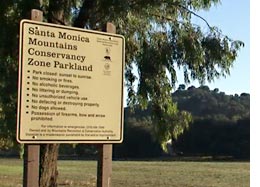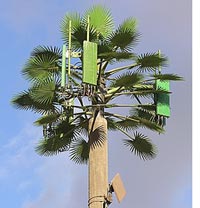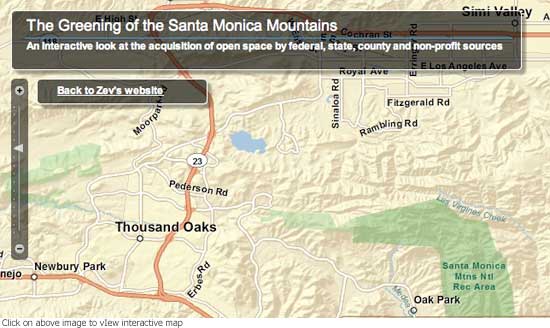A green legacy grows in the mountains
December 1, 2009

You could call it a microcosm of the Southern California landscape—but there’s nothing “micro” about the Santa Monica Mountains National Recreation Area.
 Covering 153,075 acres—more than 83,000 of them preserved as parkland and open space—the area draws millions of visitors each year to its seven state parks, campgrounds and hiking trails. To get a sense of its scope, consider these superlatives from the National Park Service: Not only is it the “world’s largest urban national park,” it has “more area codes (5) and zip codes (26), including the notable 90210 zip code of Beverly Hills, than any other unit in the National Park System.”
Covering 153,075 acres—more than 83,000 of them preserved as parkland and open space—the area draws millions of visitors each year to its seven state parks, campgrounds and hiking trails. To get a sense of its scope, consider these superlatives from the National Park Service: Not only is it the “world’s largest urban national park,” it has “more area codes (5) and zip codes (26), including the notable 90210 zip code of Beverly Hills, than any other unit in the National Park System.”
Strategic acquisitions of land—mostly in the Third District—by a coalition of local, state and federal agencies during the past 20 years have played a transformative role in shaping the recreation area into an ever-growing expanse of green. Just this fall, the National Park Service closed escrow on several parcels of land, totaling 117 acres, in Upper Solstice Canyon. The canyon—described by national parks officials as a “pristine 2,863-acre coastal watershed”—is home to waterfalls, creeks and 25 species of rare and endangered plants and animals.
To sample the rustic beauty of the recreation area and meet some of its dedicated advocates, click on the video above. And check out our interactive map to see how the green areas have expanded over the course of a generation.
County crosses signals with FCC on cell towers
December 1, 2009
 They can disguise them as palm trees, but there’s no disguising the fact that deciding where to place cellphone towers is an important—and sometimes controversial—part of the local planning process.
They can disguise them as palm trees, but there’s no disguising the fact that deciding where to place cellphone towers is an important—and sometimes controversial—part of the local planning process.
In Los Angeles County, it requires a conditional use permit. Obtaining one for a new wireless telecommunications facility can take months. The public has a chance to weigh in, and in some cases the process goes all the way to the Board of Supervisors.
But now the Federal Communications Commission, acting on a petition filed by a wireless trade association, wants to drastically speed up the process.
The Board of Supervisors says not so fast.
Concerned about the FCC directive establishing a “shot clock” requiring land use decisions on wireless facilities in as few as 90 days, the supervisors on Tuesday authorized the County Counsel to take steps to appeal the ruling or join with other local governments in doing so.
The urgent motion by Supervisors Zev Yaroslavsky and Michael D. Antonovich noted the impending deadline for filing a notice of appeal—this Thursday, December 3. The county was part of a group of local governments that took part in the FCC process and strongly opposed the commission’s Nov. 18 decision.
The motion said the FCC decision would undermine the county’s ability to use the zoning process for “the careful and thorough consideration of wireless facilities” and would in effect push cellphone towers to the head of the line for conditional use permits.
“This ruling will require giving special favored treatment to wireless telecommunication applications over other land use applications,” the motion said.
There are hundreds of wireless telecommunications facilities in the county, and requests to build new ones come in at a rapid clip, with a dozen applications and renewals pending in the next 12 weeks alone. While most are handled at the hearing officer level, some generate enough public interest and concern to reach the Regional Planning Commission or the Board of Supervisors.
Under the FCC directive, an applicant could sue if the county missed the deadline; the county would then have to go to court to present evidence “to overcome a presumption that it acted in an untimely manner,” the motion said.
Jim Hobson, an attorney who represented local entities including the county and city of Los Angeles, San Diego and Glendale in the FCC process, said local control over the placement of wireless facilities is an essential component of good zoning. Localities, he said, are in the best position to decide matters of safety, traffic and aesthetics in their areas.
He questioned whether the FCC had the authority to interpret Congress’ intent on the matter.
He noted that the FCC deadlines –90 days for “co-located” facilities in existing sites, 150 days for other applications—would be more manageable in smaller areas than Los Angeles. But he said that even in those jurisdictions there is considerable concern that the FCC will eventually insert itself into other aspects of the local planning process.
“It’s easy to be deluded by the seeming mildness of the encroachment,” Hobson said, calling the FCC decision “an entering wedge.”
The FCC decision was prompted by a petition by the wireless industry trade group CTIA. In a statement, FCC Chairman Julius Genachowski called it “an important step to cut through red tape and accelerate the deployment of next-generation wireless services.” Genachowski said the new deadlines are necessary to deal with the volume of more than 3,000 applications pending nationwide—760 of them for more than a year and 180 for more than three years.
He said the directive does not “limit state and local governments’ fundamental authority over local land use.”
In the motion, Yaroslavsky disagreed: “While the FCC claims its decision does not preempt local zoning, it does exactly that.”










 Check for the latest closure information
Check for the latest closure information








